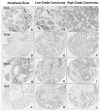Expression of hedgehog pathway components in prostate carcinoma microenvironment: shifting the balance towards autocrine signalling
- PMID: 21707705
- PMCID: PMC4934422
- DOI: 10.1111/j.1365-2559.2011.03860.x
Expression of hedgehog pathway components in prostate carcinoma microenvironment: shifting the balance towards autocrine signalling
Abstract
Aims: The hedgehog (Hh) signalling pathway has been implicated in the pathogenesis and aggressiveness of prostate cancer through epithelial-mesenchymal interactions. The aim of this study was to elucidate the cell-type partitioned expression of the Hh pathway biomarkers in the non-neoplastic and tumour microenvironments and to correlate it with the grade and stage of prostate cancer.
Methods and results: Expression of the Hh pathway components (Shh, Smo, Ptch, Gli1) in the microenvironment of non-neoplastic peripheral zone (n = 119), hormone-naive primary prostate carcinoma (n = 141) and castrate-resistant bone marrow metastases (n = 53) was analysed using immunohistochemistry in tissue microarrays and bone marrow sections. Results showed that epithelial Shh, Smo and Ptch expression was up-regulated, whereas stromal Smo, Ptch, and Gli1 expression was down-regulated in prostate carcinomas compared to non-neoplastic peripheral zone tissue. Ptch expression was modulated further in high-grade and high-stage primary tumours and in bone marrow metastases. Hh signalling correlated with ki67 and vascular endothelial growth factor (VEGF) but not with CD31 expression.
Conclusion: Our results highlight the importance of Hh-mediated epithelial-mesenchymal interactions in the non-neoplastic prostate and imply that shifting the balance from paracrine towards autocrine signalling is important in the pathogenesis and progression of prostate carcinoma.
© 2011 Blackwell Publishing Limited.
Figures



Similar articles
-
Hedgehog signaling inhibition by the small molecule smoothened inhibitor GDC-0449 in the bone forming prostate cancer xenograft MDA PCa 118b.Prostate. 2012 Nov;72(15):1638-47. doi: 10.1002/pros.22517. Epub 2012 Mar 27. Prostate. 2012. PMID: 22457212 Free PMC article.
-
Comparative expression of Hedgehog ligands at different stages of prostate carcinoma progression.J Pathol. 2008 Dec;216(4):460-70. doi: 10.1002/path.2427. J Pathol. 2008. PMID: 18825689
-
Paracrine sonic hedgehog signalling by prostate cancer cells induces osteoblast differentiation.Mol Cancer. 2009 Mar 2;8:12. doi: 10.1186/1476-4598-8-12. Mol Cancer. 2009. PMID: 19254376 Free PMC article.
-
Prostate cancer and Hedgehog signalling pathway.Clin Transl Oncol. 2007 Jul;9(7):420-8. doi: 10.1007/s12094-007-0080-x. Clin Transl Oncol. 2007. PMID: 17652055 Review.
-
Hedgehog signaling in prostate epithelial-mesenchymal growth regulation.Dev Biol. 2015 Apr 1;400(1):94-104. doi: 10.1016/j.ydbio.2015.01.019. Epub 2015 Jan 29. Dev Biol. 2015. PMID: 25641695 Free PMC article. Review.
Cited by
-
Inhibition of hedgehog signaling improves the anti-carcinogenic effects of docetaxel in prostate cancer.Oncotarget. 2015 Feb 28;6(6):3887-903. doi: 10.18632/oncotarget.2932. Oncotarget. 2015. PMID: 25682877 Free PMC article.
-
Phosphodiesterase 4D inhibitors limit prostate cancer growth potential.Mol Cancer Res. 2015 Jan;13(1):149-60. doi: 10.1158/1541-7786.MCR-14-0110. Epub 2014 Aug 22. Mol Cancer Res. 2015. PMID: 25149359 Free PMC article.
-
Stromal hedgehog signaling maintains smooth muscle and hampers micro-invasive prostate cancer.Dis Model Mech. 2017 Jan 1;10(1):39-52. doi: 10.1242/dmm.027417. Epub 2016 Nov 30. Dis Model Mech. 2017. PMID: 27935821 Free PMC article.
-
Connexin 43 and Sonic Hedgehog Pathway Interplay in Glioblastoma Cell Proliferation and Migration.Biology (Basel). 2021 Aug 12;10(8):767. doi: 10.3390/biology10080767. Biology (Basel). 2021. PMID: 34439999 Free PMC article.
-
Hedgehog signaling in prostate cancer and its therapeutic implication.Int J Mol Sci. 2013 Jul 4;14(7):13979-4007. doi: 10.3390/ijms140713979. Int J Mol Sci. 2013. PMID: 23880852 Free PMC article. Review.
References
-
- Teglund S, Toftgård R. Hedgehog beyond medulloblastoma and basal cell carcinoma. Biochim Biophys Acta. 2010;1805:181–208. - PubMed
-
- Azoulay S, Terry S, Chimingqi M, et al. Comparative expression of Hedgehog ligands at different stages of prostate carcinoma progression. J Pathol. 2008;216:460–470. - PubMed
-
- Cohen MM., Jr The hedgehog signaling network. Am J Med Genet A. 2003;123A:5–28. - PubMed
-
- Marker PC. Does prostate cancer co-opt the developmental program? Differentiation. 2008;76:736–744. - PubMed
Publication types
MeSH terms
Substances
Grants and funding
LinkOut - more resources
Full Text Sources
Medical
Miscellaneous

